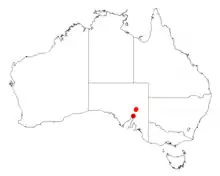Acacia spooneri
Acacia spooneri is a shrub of the genus Acacia and the subgenus Phyllodineae. It is native to a small area in South Australia
| Acacia spooneri | |
|---|---|
| Scientific classification | |
| Kingdom: | Plantae |
| Clade: | Tracheophytes |
| Clade: | Angiosperms |
| Clade: | Eudicots |
| Clade: | Rosids |
| Order: | Fabales |
| Family: | Fabaceae |
| Clade: | Mimosoideae |
| Genus: | Acacia |
| Species: | A. spooneri |
| Binomial name | |
| Acacia spooneri O'Leary | |
 | |
| Occurrence data from AVH | |
Description
The spindly and slender shrub or tree can grow to a height of 4 m (13 ft) and often has an open habit and a single stem. It has glabrous and reddish brown branchlets. Like like most species of Acacia it has phyllodes rather than true leaves. The pale green to grey-green glabrous phyllodes have a narrowly elliptic to obovate or oblanceolate shape. The coriaceous to thinly coriaceous phyllodes have a length of 2.2 to 10.2 cm (0.87 to 4.02 in) and a width of 6 to 26 mm (0.24 to 1.02 in) with a prominent central midrib and clearly visible lateral nerves. It blooms throughout the year most prolifically between May and August.[1]
Distribution
It has a disjunct distribution and is known in two areas that are situated approximately 150 km (93 mi) apart in the Flinders Range in South Australia. It is found around Brachina Gorge and Wilpena Pound in the north and around Nectar Brook on the Winninowie Range in the south. It is odften situated on rocky ridgetops as a part of mallee communities over spinifex grassland or in Callitris pine communities.[1]
See also
References
- "Acacia spooneri O'Leary". Wattle - Acacias of Australia. Lucid Central. Retrieved 6 September 2020.
- "Acacia spooneri". Australian Plant Name Index (APNI), IBIS database. Centre for Plant Biodiversity Research, Australian Government. Retrieved 2020-09-07.
- O'Leary, M.C. (2002). "Acacia spooneri (Leguminosae: Mimosoideae: Sect. Phyllodineae), a new species from the Flinders Ranges" (PDF). Journal of the Adelaide Botanic Gardens. 20: 11–15, Fig. 1.